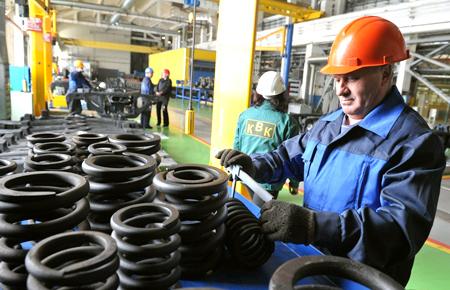ASTANA – By year 2020, the share of innovatively active enterprises is expected to increase to 20 percent of all enterprises, announced Laura Sadykova, deputy director of the Department of Technology and Innovation of the Ministry for Investment and Development on June 29.
Their implementation is included in the second five-year plan of the State Programme of Accelerated Industrial and Innovative Development (SPAIID) for 2015-2019. “We have set ourselves to ensure productivity growth by creating bases for transition to innovation-driven economy as the main objective of the second five-year plan,” Sadykova stated.
Efforts would be focused on integrated solutions in power engineering and utilities with alternative energy oriented to EXPO 2017, specified Sadykova in a statement that was carried by the on Prime Minister’s official website. She added that new materials are to include alloys with rare earth elements, robotics, automation of agricultural production, water management, bioinformatics and bioengineering, intelligent transportation and data processing software.
Series of measures aimed at reducing technological lag in metallurgy, petrochemicals, machinery, chemistry, construction and food industry are planned for adoption, according to Sadykova.
Innovation clusters will be developing within the “100 Concrete Steps” Plan of the Nation and the introduction of their products into manufacture should enhance the competitiveness of businesses, said Sadykova. At one such cluster in Almaty, engineers combined Korean and Russian technologies, added domestic savvy and made their own reliable and long lasting equipment, making their product quality higher and the cost lower than that of imported analogues, reported Khabar news agency. One-hundred-and-fifty companies including those in the fields of intelligent transportation, instrumentation and oil and gas are currently operating at the Park of Innovation Technologies (PIT) on the outskirts of Almaty, the agency reported.
Apart from Kazakh markets, the focus is also on the Eurasian Economic Community, China, India, Malaysia, Vietnam and Iran, said Sanzhar Kettebekov, CEO of the PIT autonomous fund cluster. “Two thousand jobs with highly skilled workers are created at the park now,” he said. It is also planned to involve advanced transnational companies and start-ups from the Commonwealth of Independent States for development of the innovation cluster in Kazakhstan, Khabar reported.
The second five-year plan of industrialisation has a clear focus that identified six priority areas, including oil refining, smelting, food and chemical industries, as well as production of industrial equipment and building materials, President Nursultan Nazarbayev stated in his speech on Industrialisation Day held on July 2. “The programme is based on the cluster approach and we tried to keep in mind lessons learned and based on the experience of the first five-year plan,” said Nazarbayev.
In his speech, the President stressed the necessity to increase efficiency and productivity of existing enterprises by introducing modernisation of lean production, robotics and automation as well. Nazarbayev noted the importance of the creation and development of emerging industries in Kazakhstan industries such as car production.
Nazarbayev said that industrialisation is essential to the country’s economic policy that also aims to join the 30 most-advanced countries of the world – the main goal of the Kazakhstan 2050 Strategy. In the first five years of industrialisation, nearly $33 billion in direct foreign investment was attracted to Kazakhstan and half of it came through the State Programme of Accelerated Industrial and Innovative Development, the President noted in the speech.
A number of facilities, built within the new Industrialisation Map programme and Nurly Zhol new economic policy were officially launched during a televised conference with Kazakhstan regions. In addition, the “Made in Kazakhstan” project and existing manufacturing facilities have been showcased.
According to the President, the next phase of industrialisation aims to redouble its efforts toward technological gains, and as a result of those efforts, the share of non-energy exports must double by 2025 and triple by 2040. These will be fueled by development of Nazarbayev University and the Park of Innovation Technologies – Kazakhstan’s two leading innovation clusters.
SPAIID is a part of Kazakhstan’s industrial policy focused on the development of the manufacturing industry with efforts concentrated and resources limited to a number of sectors, regional specialisation with the cluster approach and effective branch regulation.



